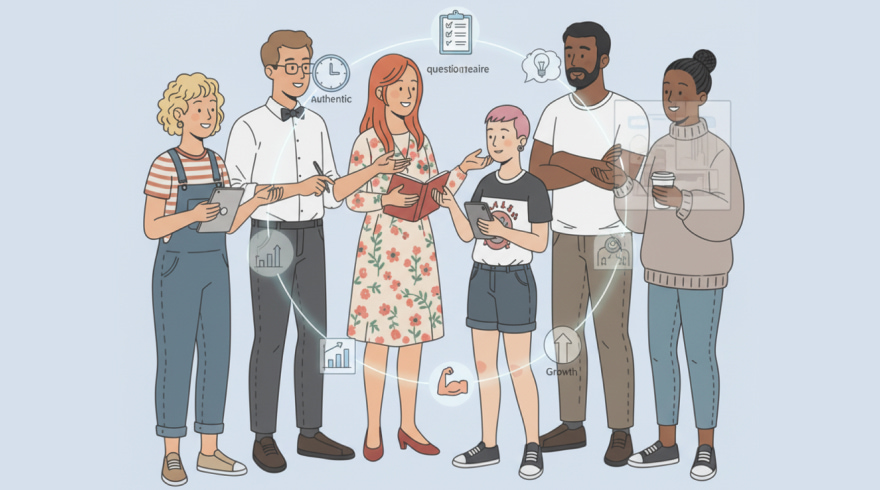The Complete Guide to Modern Leadership Capability Assessment
- 7 November 2025

What a Leadership Assessment Questionnaire Measures
Organizations thrive when decision-makers understand how they motivate others, resolve ambiguity, and convert strategy into coordinated action. A thoughtfully constructed questionnaire exposes how a manager prioritizes competing demands, communicates during stress, and shapes culture through daily habits. Rather than guessing at strengths and gaps, leaders receive structured evidence about behaviors that actually move results. This approach lowers bias, clarifies expectations, and empowers targeted development that compounds over time.
Crucially, a rigorous instrument evaluates observable behaviors aligned to a clear competency model. It examines how someone frames problems, delegates, coaches, and adapts to shifting constraints. It also captures perceptions across reporting lines, from direct reports and peers to cross-functional partners. That 360-degree vantage point illuminates blind spots, validates bright spots, and distinguishes signal from noise. When the assessment is repeated on a cadence, trend data shows whether learning translates into behavior change, not just inspiration.
Beyond individual insight, aggregated results inform workforce planning and learning investments. HR partners can identify systemic friction points, weak feedback cultures, low accountability, or inconsistent decision rights, and design interventions with measurable outcomes. Teams benefit from a shared vocabulary for excellence, making performance conversations constructive rather than personal. As clarity spreads, managers can set sharper goals, align rituals to strategic priorities, and remove blockers before they balloon into costly execution risk.
- Reveals hidden strengths and latent derailers with precision.
- Links daily behavior to long-term strategy and customer value.
- Amplifies coaching quality through common language and metrics.
- Creates ownership by translating feedback into action plans.
- Enables fairer talent decisions and transparent growth paths.
Core Competencies and Benefits You Can Benchmark Today
Competency frameworks prevent vagueness by naming what “good” and “great” look like. They transform fuzzy adjectives, like “visionary” or “decisive”, into concrete, rateable behaviors. The matrix below illustrates how key domains map to example behaviors and item prompts, making it easier to benchmark expectations across roles and levels. Use it as a reference when calibrating your instrument and selecting rater groups for the most balanced signal.
| Competency Domain | Example Behavior | Sample Item Stem | Rating Scale Tip |
|---|---|---|---|
| Strategic Orientation | Connects daily work to multi-quarter outcomes | “Links team objectives to enterprise priorities.” | Anchor 1–5 to specific planning behaviors |
| People Development | Coaches with actionable, timely feedback | “Provides growth guidance grounded in evidence.” | Distinguish frequency from impact in anchors |
| Execution Excellence | Balances speed with risk mitigation | “Delivers commitments while managing trade-offs.” | Define what “on time” and “quality” truly mean |
| Influence and Communication | Builds alignment across diverse stakeholders | “Tailors messages to audience constraints.” | Rate clarity, brevity, and audience fit separately |
Competency clarity increases psychological safety because expectations stop moving. Raters can focus on events and outcomes rather than personality judgments. This also improves fairness across cultures and functions, where “style” varies but effectiveness is consistent. Teams avoid inflated ratings by anchoring scales to behavior frequency and impact, ensuring reliability across rater groups. When competencies are transparent, managers gain a blueprint for practice and reflection between formal reviews.
Many teams blend self, upward, peer, and cross-functional input for richer context. In that model, a leadership skills assessment questionnaire becomes the backbone for reflective goal setting throughout a development cycle. With consistent architecture, you can compare cohorts, flag systemic gaps, and evaluate whether training lifts the right behaviors. The result is a pragmatic loop: data informs coaching, coaching shapes experiments, and experiments generate new data to refine the system.
- Fewer blind spots through multi-rater triangulation.
- Sharper learning design due to pattern recognition.
- Faster onboarding by codifying excellence early.
- Clearer succession planning and role mobility signals.
Designing an Effective Instrument: Items, Scales, and Bias Safeguards
Great assessments are engineered, not improvised. Start with a competency dictionary that aligns to strategy, then draft items that describe discrete, observable behaviors. Use plain language, avoid double-barreled statements, and ensure each item targets one action, not a cluster. Behavioral specificity reduces ambiguity and boosts interrater agreement, which improves the credibility of your insights with skeptical audiences.
Choose a scale that balances nuance with usability, commonly a five- or seven-point Likert anchored to clear behavior descriptors. Include “not observed” to avoid forcing guesses, and separate frequency from quality where relevant. Pilot the instrument with a small, diverse sample to test item difficulty, clarity, and response time. During piloting, capture qualitative comments to uncover misinterpretations that numbers alone might miss.
Mitigate rater bias through guidance and design. Educate participants on common pitfalls such as halo effects, leniency, recency bias, and contrast errors. Randomize item order, mix positively and negatively keyed statements where appropriate, and explain that candor fuels better coaching. Provide raters with examples of evidence-based feedback so that written comments enhance the quantitative profile. Finally, ensure accessibility and inclusive language so every participant can engage without friction.
- Map each item to one competency to avoid cross-loading.
- Limit survey length to protect data quality and completion rates.
- Collect optional context via short comment prompts.
- Localize carefully without changing behavioral intent.
Scoring, Reliability, and Validity: Turning Data Into Decisions
Numbers mean little without statistical rigor and honest interpretation. Begin by calculating internal consistency for each competency cluster; coefficients that are too low imply noisy items, while those that are too high may indicate redundancy. Examine distribution shapes, missing data patterns, and rater group differences to catch anomalies early. Convert raw scores into standardized indices when comparing across cohorts so outliers do not skew narratives.
Interpretation improves when multiple evidence streams converge. In that context, a leadership skills questionnaire gains credibility once items are behaviorally anchored and validated against performance outcomes. Build scorecards that display medians, interquartile ranges, and heat maps to spotlight where coaching will pay the biggest dividends. Use comments to qualify the numbers, distinguishing one-off events from recurring patterns that deserve priority attention.
Validity is cumulative. Correlate competence scores with lagging indicators like retention and revenue per head, but also with leading indicators such as engagement and cycle time. For developmental use, focus on deltas over time rather than one-off rankings. When decisions have high stakes, promotions, high-potential pools, combine assessment data with structured interviews and work samples to reduce single-source risk. The goal is fair, reproducible decisions that withstand scrutiny.
- Report by competency and by rater group to surface contrasts.
- Flag items with wide variance for targeted coaching.
- Set improvement thresholds to define meaningful change.
- Use dashboards that balance simplicity and diagnostic depth.
Implementation Playbook: Rollout, Ethics, and Continuous Improvement
Execution quality determines whether people trust the process. Communicate the purpose upfront: developmental growth, not surveillance. Clarify confidentiality boundaries, explain who sees what, and outline the timeline from invitation to debrief. Make it easy to participate with mobile-friendly forms and clear instructions, and appoint a program owner who monitors completion rates and nudges stakeholders with empathy, not pressure.
After data collection, deliver feedback in a psychologically safe setting. Provide a facilitated debrief that connects insights to the person’s context and goals. Translate findings into two or three high-leverage experiments, specific behaviors to practice, not vague aspirations. Schedule follow-ups at 30, 60, and 90 days to reinforce momentum, and thread insights into one-on-ones, sprint rituals, and performance reviews so growth sticks.
Ethics matter. Store data securely, restrict access on a need-to-know basis, and separate developmental information from compensation decisions wherever possible. Share aggregate trends with the organization to promote transparency while protecting individuals. Finally, iterate: retire weak items, refine anchors, and refresh the competency model as strategy evolves. A living system outperforms a static artifact because it keeps pace with the business and the people powering it.
- Communicate intent, process, and privacy in plain language.
- Support managers with guides and coaching templates.
- Integrate insights into workflows, not just workshops.
- Measure outcomes and reinvest in what works.
FAQ: Common Questions Answered
How long should a well-designed questionnaire take to complete?
Most instruments aim for 10–15 minutes to protect attention and maintain high-quality responses. That typically translates to 25–35 behaviorally specific items plus a handful of short comment prompts. Brevity matters, but don’t sacrifice diagnostic value; focus on the competencies that drive strategy today rather than an exhaustive encyclopedia of traits. Pilot the timing with a cross-section of roles to confirm the estimate in real-world conditions.
What rater groups produce the most actionable insight?
A blend of self, manager, direct reports, peers, and selected cross-functional partners yields the richest view. Each group witnesses different moments, planning, execution, conflict, and recovery, so triangulation reduces single-perspective distortion. For early-career managers, prioritize upward feedback and peers; for senior leaders, include stakeholders from adjacent business units to capture systems-level influence. Always guide raters so comments are concrete and respectful.
How often should assessments be repeated?
Twice yearly works for most teams: once to establish a baseline and again to measure change after targeted practice. Avoid running assessments so frequently that respondents experience fatigue or leaders chase vanity metrics. In high-change environments, quarterly pulses on a narrow set of items can track a specific initiative while the broader assessment remains semiannual. The cadence should align to development cycles and business planning rhythms.
What makes item wording effective and fair?
Great items describe observable behavior in plain language and avoid jargon, absolutes, and double-barreled constructions. They should be relevant across functions and cultures, with anchors that define what different points on the scale look like in action. Include a “not observed” option, separate frequency from impact when necessary, and test translations carefully. Ask a diverse review panel to surface ambiguous phrasing before you launch at scale.
How do we turn results into practical growth plans?
Start by selecting two or three high-leverage behaviors that, if improved, would cascade benefits across outcomes. Convert each into a specific experiment, who, what, when, and how you will practice, and define evidence that proves progress. Pair the plan with a coach or manager check-in schedule, and integrate micro-habits into existing meetings and workflows. Celebrate small wins to reinforce momentum, and revisit the plan after 60–90 days to refine or escalate.



